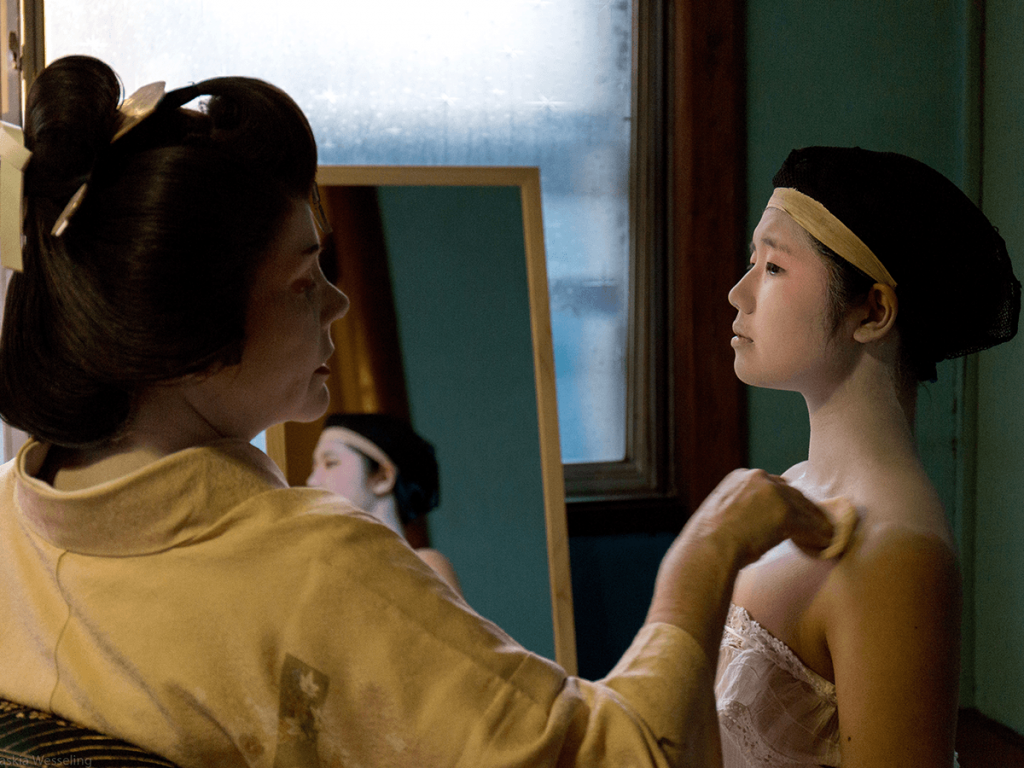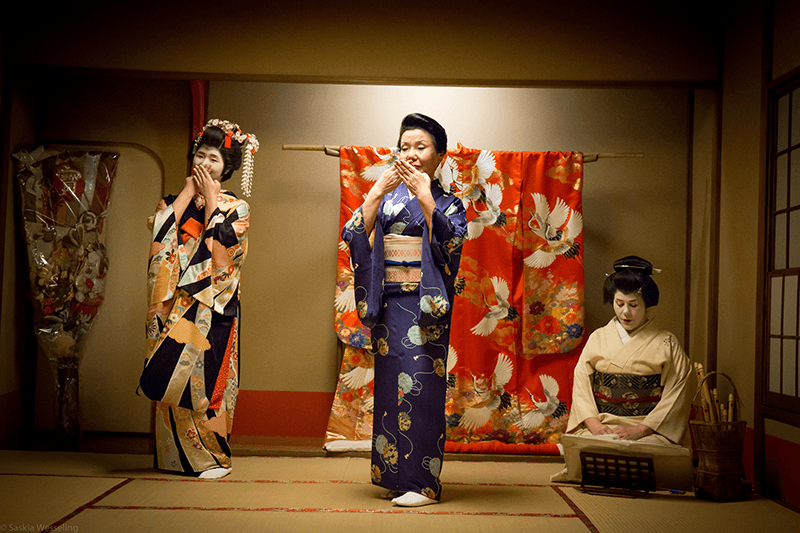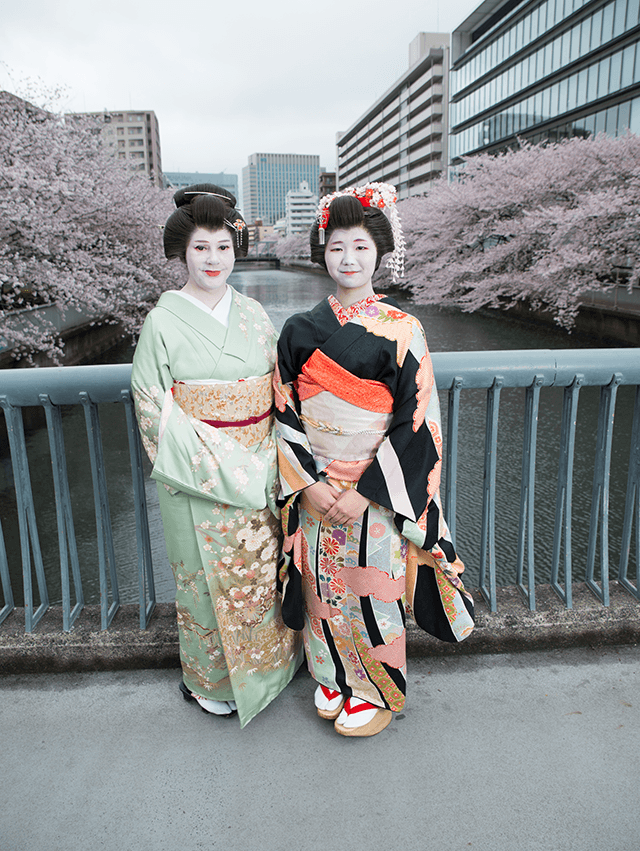Geisha are some of the most iconic figures of traditional Japanese culture and yet remain cloaked in a veil of mystery and strict etiquette. We spoke with Sayuki, Japan’s first foreign geisha, to find out about her daily life and learn more about her unique profession.
What is your typical day like?
Normally, I correspond with customers in the morning, practice or do classes in the afternoon, and do banquets when I have bookings in the evening. I am a flute specialist and do classes at different times of the year for flute: in nagauta music from the kabuki theatre, hauta and kouta – “little songs” that are like haiku set to music (and are the most common type of geisha music) – festival music, lion dance music, and minyo folk music. I also take lessons in singing and shamisen.
Why did you choose this job?
I was working previously on documentaries for NHK, the BBC, National Geographic Channel and other broadcasters. While I was trying to sell the idea of a behind-the-scenes geisha documentary, I suggested that I be the geisha being trained and filmed over a year. After my initial planned year was up I had only just debuted – and wanted to learn so much more – so I asked and got permission from the Asakusa Geisha Association to continue as a geisha. I would still love to make my own program, about how I am currently helping the Fukagawa geisha to revive their district.
How do you become a geisha?
You train by being accepted into a geisha house, most often in a recognized geisha district. All the training is done by following one’s geisha mother around in her everyday activities and learning by example, and by taking lessons in music and/or dance. Once the new geisha can perform well enough to attend banquets she learns how to entertain by watching her older sisters work. How long this takes depends on how strict the district is. Some Kyoto maiko debut in as little as three months, but in conservative Asakusa, I did a very long apprenticeship for 11 months. As does any trainee who is past her early twenties, I debuted directly as a geisha rather than as a maiko or hangyoku as they are called in Tokyo.
What is the most important aspect of being a geisha?
Geisha need to be everything to everyone. A banquet with Japanese guests who have been commuting to the geisha world for decades is different to a banquet for first-time foreign tourists, and different again to an expat family party with kids. We always need to be aware of how we can cater best to our customers and make sure they have a wonderful time. It takes time to learn to be very sensitive and always aware of our customers’ needs. In the end, though, if a geisha does not love her art, then it doesn’t last.
What’s the best part of the job?
To be a geisha is to be in a very beautiful world, surrounded by beautiful women, and beautiful things, and entertaining in beautiful places. It is difficult to have a truly beautiful life, but this comes close to it. Now we are in the first days of autumn, for my next banquet I will choose a single-layered silk kimono, with a design predicting the autumn soon to come. I have hundreds of kimono now, but a geisha can never have enough! There is a lot of giving and receiving of kimono in the geisha world: the geisha mother I had when I was in Asakusa called me out just recently to give me another of hers: a beautiful dark blue banquet kimono with fine gold patterns.
What’s the most unexpected part of job?
Many people think that a banquet is a very stiff formal occasion, but depending on what the customers want, banquets can be very raucous! The older Fukagawa geisha have some great drinking games and Japanese really love to get into the swing of things. At a recent banquet things got so wild that we had to keep covering the trainee geisha’s eyes!
Why would you recommend people try the geisha experience?
To attend a genuine geisha banquet is to see the most beautiful of traditional Japanese architecture in the teahouses, the most precious artworks, and calligraphy and pottery in the interiors
of the teahouses, the best of Japanese kimono in the geisha’s attire, and the best of Japanese cuisine and sake, and of course, an introduction to Japanese music and dance. There is no other single experience or occasion in which you can get such a completely comprehensive cultural experience.
What kind of event would you recommend hiring a geisha for?
Every occasion! Apart from the normal banquet, geisha have always been hired for celebratory occasions of any kind. Geisha appear at the openings of new shops, or on the first day of the sumo or theatre. In modern times, we have danced at Narita Airport for the opening of new flights, danced at Frankfurt Messe trade show, attended parties at private homes, gone out on boats in Tokyo Bay or even entertained on the ski slopes in Niseko. Geisha can be called anywhere in the world too.
I very much welcome any ideas to connect with new audiences.
Is it expensive to call a geisha, and what are some of the options?
It is the ratio of geisha to customers that decides the price, so if you want to make it cheaper, get some friends together and organize a larger group. Our most exciting new project for the Fukagawa geisha is our Geisha School. We have opened up the lessons of the little geisha for the very first time, so that anyone can come and watch a dance or music lesson by the older geisha. This is a very cheap way to meet geisha, and a great way to support the geisha world, as all proceeds will go directly to the training of the young geisha. If you would like to visit a teahouse, just email me and let me know how many people you are, and what your maximum budget is per person, then I can make all the arrangements for you. Recently I have been given the use of a beautiful 100-year-old house in Kamakura. We can arrange private parties there, or customers can use the house for the weekend with a banquet on a Friday or Saturday. We are happy to cater for a range of budgets.
What other services do you offer?
Apart from banquets, I offer a number of other activities including “lunch with Sayuki” (a lunch with me to talk about the geisha world), geisha shopping (visiting the beautiful little shops and craftsmen making the products that geisha use), kimono shopping (a complete introduction to kimono by visiting the best recycled kimono shops), antique market shopping (finding genuine samurai armour or geisha pillows, antique pottery and ukiyo-e paintings, all at rock bottom prices), kabuki viewing (offering extra commentary while watching kabuki).
Call Sayuki
You can contact Sayuki directly at [email protected] for all enquiries, and to call her and her geisha sisters to events across Tokyo and beyond. Find out more at www.sayuki.net

Geisha Encounter: Cultural Experience at Chaya in Tokyo
Dinner with a Top Level Geisha Performance in Kagurazaka, Tokyo
Authentic Kimono Makeover and Studio Photography in Tokyo
See a Unique Oedo Oiran (Courtesan) Geisha Show
Updated On December 28, 2022











